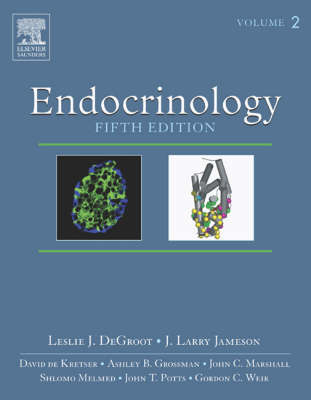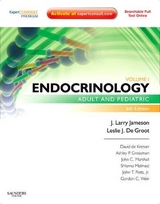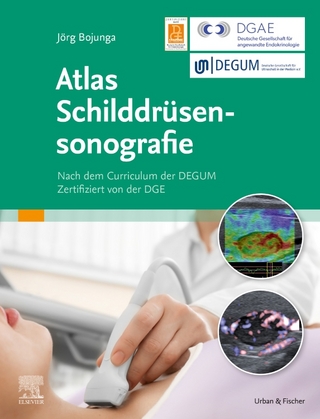
Endocrinology
W B Saunders Co Ltd (Verlag)
978-0-7216-0376-6 (ISBN)
- Titel erscheint in neuer Auflage
- Artikel merken
Revised throughout, the 5th edition of this leading reference presents a complete and up-to-date review and analysis of all aspects of endocrinology, diabetes, and bone metabolism. Readers will also find state-of-the-art information on genetics, proteinomics, and hormone signaling, and coverage of the field's hottest topics in nearly 20 new chapters. Joined by an international team of leading experts - many new to this edition - Drs. Jameson and DeGroot provide guidance that integrates the basic science of endocrinology with clinical medicine and the practical management of endocrine disorders. A clinical focus emphasizes diagnosis and therapy.
I. PRINCIPLES OF HORMONE ACTION 1. Endocrinology: Impact on science and medicine II. GENOMICS & ENDOCRINOLOGY 2.Hormones and gene expression: basic principles 3.Cell division, differentiation, senescence, and death 4.Appication of genomics and proteinomics to endocrinology 5.Transgenic and genetic animal models 6.Genetic syndromes in endocrinology III.MECHANISMS OF ENDOCRINE SIGNALING & RESPONSE 7.Control of hormone secretion 8.Hormone signaling via tyrosine kinase receptors 9.Hormone signaling via cytokine receptors 10.Hormone signaling via serine kinase receptors 11.Hormone signaling via G-protein coupled receptors 12.Cyclic AMP signaling pathway 13.Second messenger signaling pathways: Phospholipids and calcium 14.MAP kinase and growth factor signaling pathways 15.Nuclear receptors: Sturcture, function and co-factors IV. NEUROENDOCRINOLOGY & PITUITARY DISEASE 16.Development of the pituitary 17.Prolactin 18.ACTH 19.Endocrine rhythms and the clock 20.Hypothalamic syndromes 21.Evaluation of hypothalamic and pituitary masses 22.Hypopituitarism 23.Acromegaly 24.Cushing's Disease and Syndrome 25.Non-functioning ademonas and gonadotrophinomas 26.TSH-producing adenomas 27.Prolactinoma 28.Pituitary surgery 29.Evaluation and management of childhood hypothalamic and pituitary tumors 30.Posterior pituitary, diabetes insipidus, SIADH 31.The pineal gland: basic physiology and clinical implications V. GROWTH & MATURATION 32.Growth hormone 33.Regulation of GH secretion 34.ICH-I, IGF-BPs, and IFG-II 35.Other growth factors 36.Growth and maturation 37.Growth hormone deficiency in children 38.Growth hormone deficiency in adults VI. IMMUNOLOGY & ENDOCRINOLOGY 39.Autoimmune endocrine disease 40.Interactions of the Endocrine and Immune Systems 41.Autoimmune polyglandular failure syndromes VII.OBESITY, ANOREXIA, AND NUTRITION 42.Appetite regulation and thermogenesis 43.Obesity: The problem and its management 44.Genetics and syndromes of obesity ( 45.Anorexia Nervosa, Bulimia Nervosa, and other eating disorders 46.Starvation and parenteral VIII.DIABETES MELLITUS 47.Development of the endocrine pancreas 48.Chemistry and biosynthesis of the islet hormones 49.Secretion and metabolism of insulin 50.Insulin action 51.Glucagon and the glucagon-like peptides 52.Integrated control of energy substrate utilization 53.Role of the adipocyte in metabolism and endocrine function 54.Classification and diagnosis of diabetes mellitus 55.Type 1 (Insulin-dependent) diabetes mellitus: Etiology, pathogenesis, and natural history 56.Type 2 diabetes mellitus: Etiology, pathogenesis, and natural history 57.Hyperglycemia secondary to non-diabetic conditions and therapies 58.Syndromes of insulin resistance and lipodystrophy 59.Metabolic syndrome 60.Treatment of Type 1 diabetes mellitus in adults 61.Ketoacidosis and hyperosmolar coma 62.Hypoglycemia 63.Management of Type 2 diabetes mellitus 64.Management of diabetes in children 65.Pancreatic and islet transplantation 66.Relationship of diabetic control to complications 67.Diabetic oculopathy 68.Diabetic neuropathy 69.Diabetic nephropathy 70.Diabetic foot and vascular complications IX.PARATHYROID GLAND, CALCIOTROPIC HORMONES & BONE METABOLISM 71.Parathyroid hormone and parathyroid hormone-related peptide 72.Calcitonin 73.Vitamin D 74.Regulation of calcium homeostasis 75.Bone development and remodeling 76.Genetic defects in the parathyroid axis 77.Hyperparathyroidism: Differential diagnosis of 78.Malignancy-associated hypercalcemia 79.Medical treatment of hypercalcemia 80.Surgical management of hypercalcemia 81.Familial hypocalciuric hypercalcemia and other disorders due to calcium-sensing receptor mutations 82.Hypoparathyroidism and pseudohypoparathyroidism 83.Genetic defects in vitamin D metabolism and action 84.Nephrolithiasis 85.Genetic Defects and Disorders of Bone 86.Bone imaging and assessment of bone density 87.Renal osteodystrophy 88.Osteomalacia and rickets 89.Osteoporosis 90.Paget's Disease of bone X.THYROID 91.Development of the 92.Thyroid-stimulating hormone and regulation of the thyroid 93.Thyroid hormone formation 94.Thyroid Regulatory 95.Thyroid hormone metabolism 96.Thyroid hormone action 97.Throid function tests: Effects of drugs and disease on the thyroid 98.Thyroid 99.Autoimmune thyroid disease 100.Graves' Disease 101.Graves' Ophthalmopathy 102.Other causes of hyperthyroidism 103.Chronic (Hashimoto's) thyroiditis 104.Subacute and Reidel's thyroiditis 105.Hypothyroidism and myxedema coma 106.Nonthyroidal illness syndrome 107.Multinodular goiter 108.Iodine defieciency 109.Thyroid nodules and Thyroid 110.Medullary thyroid carcinoma 111.TSH receptor mutations 112.Genetic Defects in Thyroid Hormone Synthesis and Action: Defects in Thyroid Hormone 113.Thyroid Hormone Binding and Variants of Transport Proteins 114.Resistance to thyroid hormone 115.Surgery of the thyroid: Abberant thyroid masses XI.ADRENAL GLAND AND ADRENAL HORMONES 116.The principles, pathways, and enzymes of human steroidogenesis 117.Glucocorticoid physiology 118.Gulcocorticoid receptors and their mechanisms of action 119.Aldosterone: Secretion and 120.Glucocorticoid therapy 121.Adrenal insufficiency/Cushing's Disease 122.Adrenal causes of hypercortisolism 123.Generalized Glucocorticoid resistance 124.Congenital adrenal 125.Adrenarche and adrenopause 126.Adrenal imaging and adrenal incidentaloma 127.Adrenal neoplasia 128.Primary mineralocorticoid excess 129.Mineralocorticoid deficiency 130.Pheochromocytoma 131.Adrenal surgery XII.CARDIOVASCULAR ENDOCRINOLOGY 132.Hormones of the cardiovascular system 133.Hormonal regulation of electrolyte and water metabolism 134.Endocrine changes in CHF 135.Management of lipid disorders 136.Essential hypertension and endorine hypertension 137.Orthostatic hypotension XIII.ENDOCRINE CHANGES IN CRITICALLY ILL PATIENTS 138.Endocrine aspects of critical care XIV.REPRODUCTIVE ENDOCRINOLOGY AND SEXUAL FUNCTION 139.GnRH and gonadotropins 140.Gonadal peptides: Inhibins, activins, follistatin, MIS 141.Regulation of gonadotropin synthesis and secretion 142.Genetic basis of sexual differentiation 143.Embryology and control of sex differentiation 144.Endocrinology of sexual maturation 145.Environmental agents and the reproductive system 146.Diagnosis and treatment of disorders of sexual development 147.Precocious puberty 148.Delayed puberty 149.Gender identity and sexual behavior XV.FEMALE REPRODUCTION 150.Folliculogenesis, ovulation, and luteogenesis 151.Ovarian hormone synthesis and secretion 152.Estrogen and progesterone action 153.Hormonal regulation of the menstrual cycle and mechanisms of ovulation 154.Amenorrhea, anovulation, and dysfunctional uterine bleeding 155.Endometriosis 156.Female infertility: Evaluation and management 157.Polycystic ovarian syndrome, hirsutism, and hyperandrogenism 158.Ovulation induction and assisted reproduction 159.Contraception 160.Female sexual dysfunction 161.Premenstual syndrome 162.Mechanisms of menopause and the menopausal transition 163.Ovarian tumors with endocrine manifestations XVI.ENDOCRINOLOGY OF THE BREAST 164.Hormonal control of the breast development 165.Benign breast disorders 166.Breast cancer and hormonal mangement XVII. MALE REPRODUCTION 167.Spermatogenesis and regulation of testicular function 168.Androgens and androgen action 169.Androgen receptors and androgen insensitivity syndromes 170.Androgen deficiency disorders 171.Cryptorchidism and hypospadias 172.Male infertility 173.Male sexual dysfunction 174.Male contraception 175.Testicular tumors with Endocrine Manifestations 176.Use and abuse of anabolic steroids 177.Gynecomastia 178.Physiology and pathophysiology of androgenetic alopecia 179.Endocrinology of the Prostate and Benign Prostatic Hyperplasia 180.Prostate cancer XVIII. ENDOCRINOLOGY OF PREGNANCY 181.Implantation and placental physiology 182.Placental hormones 183.Fetal and neonatal endocrinology 184.Fuel homeostasis in the fetus and neonate 185.Endocrinology of partuition 186.Diabetes mellitus and pregnancy 187.Diagnosis and treatment of thyroid disease during pregnancy 188.Lactation 189.Gestational trophoblastic neoplasms 190.Hormonal changes and endocrine testing in pregnancy XIX. ENDOCRINE TUMOR SYNDROMES 191.Multiple endocrine neoplasia Type 1 192.Multiple endocrine neoplasia Types IIa and IIb 193.Gastrointestinal hormones and tumor syndromes 194.Carcinoid syndrome 195.Ectopic hormone syndromes XX. ENDOCRINE TESTING AND ENDOCRINE DRUG 196.Endocrine testing
| Erscheint lt. Verlag | 4.10.2005 |
|---|---|
| Zusatzinfo | Approx. 1450 illustrations (100 in full color) |
| Verlagsort | London |
| Sprache | englisch |
| Maße | 216 x 276 mm |
| Gewicht | 1000 g |
| Themenwelt | Medizinische Fachgebiete ► Innere Medizin ► Endokrinologie |
| ISBN-10 | 0-7216-0376-9 / 0721603769 |
| ISBN-13 | 978-0-7216-0376-6 / 9780721603766 |
| Zustand | Neuware |
| Haben Sie eine Frage zum Produkt? |
aus dem Bereich



